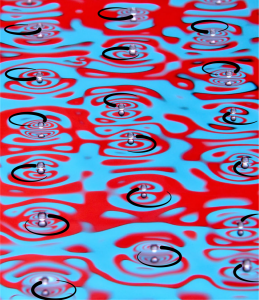
A hundred years after the birth of quantum mechanics, a UNC mathematics professor has utilized a new hydrodynamic system to visualize behaviors reminiscent of electronic spin systems, providing new insight into how particles may operate on the quantum level.
These findings were published in Nature on Aug. 4.
In the Physical Mathematics Laboratory in UNC-Chapel Hill’s College of Arts & Sciences, Pedro Sáenz and his students combine theory, simulations and experiments to better understand fundamental problems in physics and engineering. They work to demonstrate that some odd behaviors displayed by electrons and other atomic-sized particles can be recreated with larger particles visible to the human eye.
One such experiment includes the close observation of tiny vibrating liquid droplets.
Modeling the motion of microscopic particles has big implications for quantum computations and spintronics. A better understanding of these behaviors could also have widespread applications across multiple scientific fields, including physics, engineering and computer science.

“The system consists of millimeter-scale droplets spontaneously ‘walking’ on the surface of a vibration bath through a resonant interaction with their own wave field,” said Sáenz, who is the lead author on the paper.
This walking-droplet system, discovered 16 years ago by a group in Paris, demonstrates behaviors previously thought to be exclusive to quantum particles. In their paper published in Nature, Saenz and his colleagues take it a step further.
“We have been able to demonstrate how orbiting droplets coupled through waves spontaneously arrange themselves into collective states that resemble magnetic spin ordering,” Sáenz said.
For example, consider the spin property of electrons, which can be thought of as an internal rotation about a spin axis. When the microscopic particles are arranged in a “spin lattice,” the way in which these spins are collectively oriented determines the magnetic properties of the material.
John Bush, a professor of applied mathematics at MIT and senior author on the paper, said this system has the potential to solve long-standing problems in modeling microscopic particles. “Back in the early days of quantum mechanics, researchers developed a mathematical framework, but didn’t have the means to generate the associated physical picture,” Bush said. “A number of us now believe that a plausible physical picture is emerging from this system.”
“We don’t want to accept that something exists for no reason — which you sometimes have to do in quantum mechanics,” Sáenz added. In our case, we can explain all the details. We don’t have to accept what we cannot see.”
Bush added that this work is what scientists should be doing in trying to understand the physical world.
“We don’t just want an equation that gives us the answer. We want to have a mechanistic understanding at the deepest level,” he said.
Learn more about Sáenz’s research in this Endeavors article.
By Mary Lide Parker
